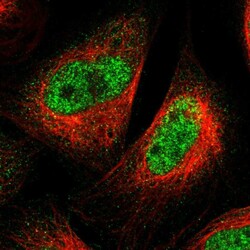Antibody data
- Antibody Data
- Antigen structure
- References [7]
- Comments [0]
- Validations
- Immunocytochemistry [1]
Submit
Validation data
Reference
Comment
Report error
- Product number
- HPA025073 - Provider product page

- Provider
- Atlas Antibodies
- Proper citation
- Atlas Antibodies Cat#HPA025073, RRID:AB_1847695
- Product name
- Anti-SPRTN
- Antibody type
- Polyclonal
- Description
- Polyclonal Antibody against Human SPRTN, Gene description: SprT-like N-terminal domain, Alternative Gene Names: C1orf124, DKFZP547N043, DVC1, Spartan, Validated applications: ICC, Uniprot ID: Q9H040, Storage: Store at +4°C for short term storage. Long time storage is recommended at -20°C.
- Reactivity
- Human
- Host
- Rabbit
- Conjugate
- Unconjugated
- Isotype
- IgG
- Vial size
- 100 µl
- Concentration
- 0.1 mg/ml
- Storage
- Store at +4°C for short term storage. Long time storage is recommended at -20°C.
- Handling
- The antibody solution should be gently mixed before use.
Submitted references A Novel Approach: Investigating the Intracellular Clearance Mechanism of Glyceraldehyde-Derived Advanced Glycation End-Products Using the Artificial Checkpoint Kinase 1 d270KD Mutant as a Substrate Model
Replication-associated formation and repair of human topoisomerase IIIα cleavage complexes.
The protease SPRTN and SUMOylation coordinate DNA-protein crosslink repair to prevent genome instability
SPRTN protease-cleaved MRE11 decreases DNA repair and radiosensitises cancer cells.
SPRTN is a mammalian DNA-binding metalloprotease that resolves DNA-protein crosslinks
Immunofluorescence and fluorescent-protein tagging show high correlation for protein localization in mammalian cells
DVC1 (C1orf124) is a DNA damage–targeting p97 adaptor that promotes ubiquitin-dependent responses to replication blocks
Takeda K, Sakai-Sakasai A, Kajinami K, Takeuchi M
Cells 2023;12(24):2838
Cells 2023;12(24):2838
Replication-associated formation and repair of human topoisomerase IIIα cleavage complexes.
Saha LK, Saha S, Yang X, Huang SN, Sun Y, Jo U, Pommier Y
Nature communications 2023 Apr 6;14(1):1925
Nature communications 2023 Apr 6;14(1):1925
The protease SPRTN and SUMOylation coordinate DNA-protein crosslink repair to prevent genome instability
Ruggiano A, Vaz B, Kilgas S, Popović M, Rodriguez-Berriguete G, Singh A, Higgins G, Kiltie A, Ramadan K
Cell Reports 2021;37(10):110080
Cell Reports 2021;37(10):110080
SPRTN protease-cleaved MRE11 decreases DNA repair and radiosensitises cancer cells.
Na J, Newman JA, Then CK, Syed J, Vendrell I, Torrecilla I, Ellermann S, Ramadan K, Fischer R, Kiltie AE
Cell death & disease 2021 Feb 8;12(2):165
Cell death & disease 2021 Feb 8;12(2):165
SPRTN is a mammalian DNA-binding metalloprotease that resolves DNA-protein crosslinks
Lopez-Mosqueda J, Maddi K, Prgomet S, Kalayil S, Marinovic-Terzic I, Terzic J, Dikic I
eLife 2016;5
eLife 2016;5
Immunofluorescence and fluorescent-protein tagging show high correlation for protein localization in mammalian cells
Stadler C, Rexhepaj E, Singan V, Murphy R, Pepperkok R, Uhlén M, Simpson J, Lundberg E
Nature Methods 2013;10(4):315-323
Nature Methods 2013;10(4):315-323
DVC1 (C1orf124) is a DNA damage–targeting p97 adaptor that promotes ubiquitin-dependent responses to replication blocks
Mosbech A, Gibbs-Seymour I, Kagias K, Thorslund T, Beli P, Povlsen L, Nielsen S, Smedegaard S, Sedgwick G, Lukas C, Hartmann-Petersen R, Lukas J, Choudhary C, Pocock R, Bekker-Jensen S, Mailand N
Nature Structural & Molecular Biology 2012;19(11):1084-1092
Nature Structural & Molecular Biology 2012;19(11):1084-1092
No comments: Submit comment
Supportive validation
- Submitted by
- Atlas Antibodies (provider)
- Main image

- Experimental details
- Immunofluorescent staining of human cell line U-2 OS shows localization to nucleoplasm.
- Sample type
- Human
 Explore
Explore Validate
Validate Learn
Learn Immunocytochemistry
Immunocytochemistry